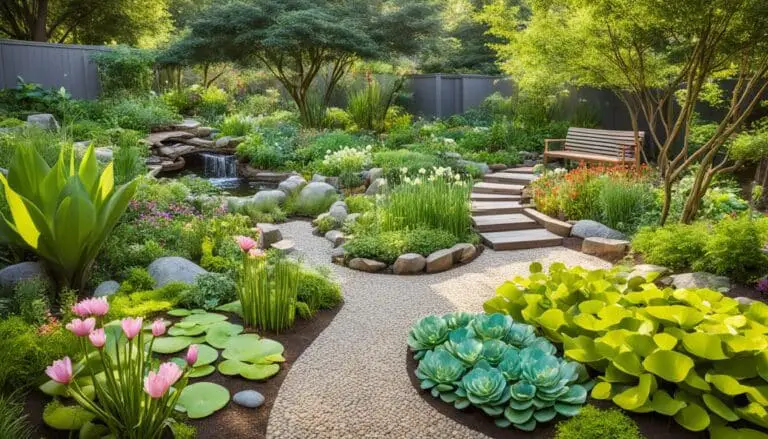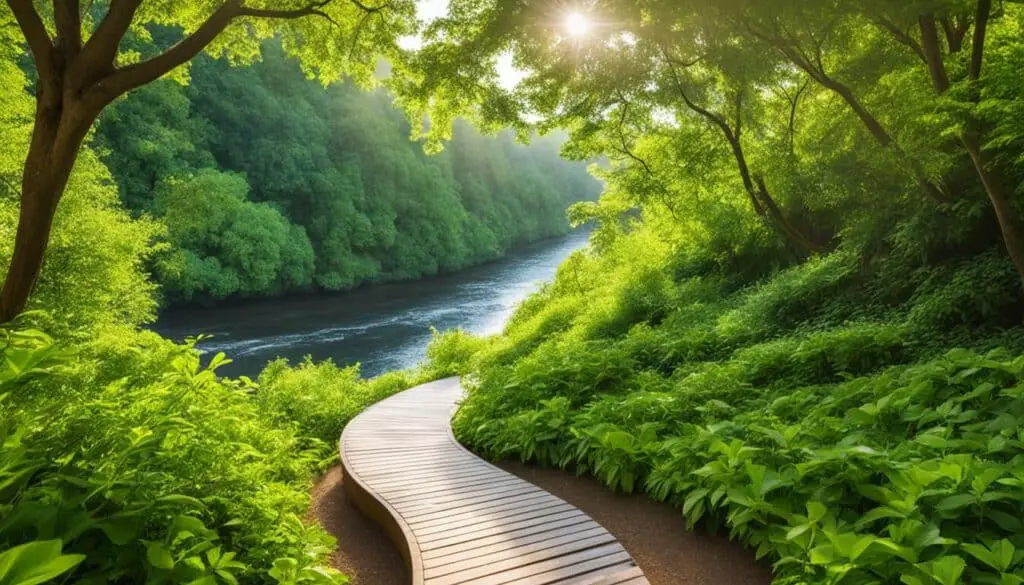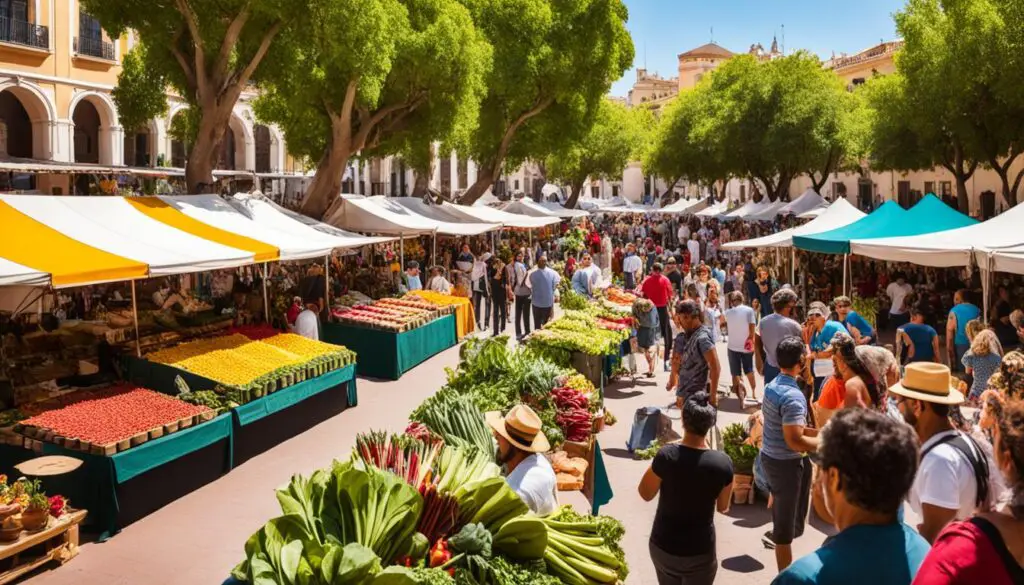When it comes to creating a beautiful yard, there are countless options to choose from. However, if you’re looking to enhance your outdoor space while also being mindful of the environment, green landscaping ideas can be the perfect solution. By incorporating sustainable practices and eco-friendly elements into your yard, you can create a beautiful oasis that benefits both you and the planet.
Valencia, Spain has recently been recognized as the European Green Capital for 2024, thanks to its ambitious sustainability strategy and efforts to transition to clean energy. This vibrant city is renowned for its green spaces, such as Albufera National Park, and is implementing various green initiatives to become carbon neutral by 2030. Inspired by Valencia’s success, you too can make a positive impact through your yard.
Key Takeaways:
- Green landscaping ideas can help you create a beautiful yard while reducing your environmental footprint.
- Valencia, Spain, the European Green Capital for 2024, showcases the benefits of sustainable practices.
- Incorporating native plants, using organic fertilizers, and implementing water-saving techniques are some eco-friendly landscaping ideas.
- Supporting local and sustainable textile practices is another way to contribute to a greener future.
- By adopting these green landscaping ideas, you can enhance your yard’s beauty and contribute to a more sustainable world.
Valencia’s Green Initiatives for a Greener City
In its quest to become carbon neutral by 2030, Valencia is spearheading several innovative green initiatives. These initiatives not only promote sustainability but also enhance the quality of life for its residents. By embracing renewable energy sources, implementing smart solutions, and fostering community engagement, Valencia is leading the way towards building a greener and more sustainable city.
Supplying Air Conditioning with Rooftop Solar Panels
Valencia has taken a significant step in making the Cabanyal Municipal Market a sustainable hub by integrating rooftop solar panels. This eco-friendly approach not only provides renewable energy for cooling the market but also helps reduce its carbon footprint. By harnessing the power of the sun, Valencia is demonstrating its commitment to sustainable energy solutions.
The ‘Socialized Solar Plant’
“The ‘socialized solar plant’ in Valencia is a groundbreaking project that involves individual citizens in the city’s transition to clean energy. Through their contributions, residents have the opportunity to invest in solar panels installed in public spaces, enabling them to actively participate in the journey towards a carbon-neutral future.”
Smart Lighting and EV Charging Points
Valencia is taking advantage of technology to create a smarter and more sustainable cityscape. The implementation of smart lighting systems not only reduces energy consumption but also enhances safety and efficiency. Additionally, the installation of electric vehicle (EV) charging points along the seafront supports sustainable mobility options and encourages the adoption of electric vehicles.
In recognition of its commitment to sustainability and environmental stewardship, Valencia has been named the European Green Capital for 2024. These accolades further solidify the city’s position as a global leader in green initiatives and inspire other cities to follow suit.
Enhancing Green Spaces in Valencia
Valencia is renowned for its abundant green spaces, which include beautiful gardens and the breathtaking Albufera National Park. These green spaces not only add to the city’s charm but also play an essential role in promoting sustainability and conservation.
The city of Valencia takes great pride in its more than two million square meters of gardens, attracting tourists and locals alike. These meticulously designed gardens showcase a vibrant array of plant species, creating a serene environment for relaxation and enjoyment.
“Valencia’s gardens offer a peaceful escape from the bustling city streets,” says Maria Rodriguez, a local resident. “I love spending time in these green oases, surrounded by nature’s beauty.”
One of the most notable green spaces near Valencia is the Albufera National Park. Located just 10 kilometers south of the city center, this protected lagoon area serves as Valencia’s “green lung.”
The Albufera National Park is a natural haven that supports a diverse range of wildlife, hosting over 300 species of birds. Visitors have the opportunity to spot rare and migratory bird species, making it a favorite destination for birdwatchers and nature enthusiasts.
“Exploring the Albufera National Park is like stepping into a different world,” explains Juan Martinez, a tourist from Barcelona. “The tranquility and biodiversity of this natural gem are truly awe-inspiring.”
The image showcases the breathtaking beauty of Albufera National Park, capturing the essence of Valencia’s green spaces.
Valencia’s commitment to maintaining and enhancing these green spaces demonstrates its dedication to environmental sustainability. The city’s efforts not only preserve natural habitats but also contribute to its reputation as the greenest city in Europe.
By valuing and nurturing these green spaces, Valencia sets an example for other cities worldwide to prioritize nature preservation and create a sustainable future for generations to come.
Valencian Green Routes: Exploring Nature and Sustainability
Valencia has crafted three captivating routes that allow residents and visitors to immerse themselves in the city’s unparalleled natural beauty and witness its commitment to sustainable mobility and the revitalization of public spaces. These Valencian green routes offer a unique opportunity to connect with nature while promoting sustainable practices and experiencing the city’s vibrant culture.
The “Green River” Route: Unveiling the Spectacle of Turia Garden
The first route, known as the “Green River” route, traverses the magnificent Turia Garden, an expansive urban park stretching along what was once the Turia River. This mesmerizing green corridor serves as a natural filter and sponge, ingeniously retaining and purifying water, making it an integral part of Valencia’s sustainable water management system. As you stroll along the route, you’ll encounter lush gardens, picturesque bridges, and recreational spaces, creating a serene oasis in the heart of the city.
The Second Route: Championing Sustainable Mobility
The second route showcases Valencia’s dedication to sustainable mobility by highlighting pedestrianized streets and squares. As you explore these car-free areas, you’ll marvel at the harmonious blend of historic architecture, lively plazas, and bustling street life. This route invites you to discover Valencia at a leisurely pace, fostering a deeper connection with the city and reducing your carbon footprint.
The Third Route: Valencia’s “Three Natural Pantries”
Valencia’s third route encapsulates its renowned “three natural pantries,” each offering a diverse and enriching experience of nature. The first pantry introduces you to the captivating peri-urban orchard, where you can witness the cultivation of traditional crops and learn about sustainable agricultural practices. The second pantry embraces the Mediterranean Sea, inviting you to explore its pristine beaches, indulge in water sports, or simply soak up the sun. The final pantry showcases the picturesque rice fields surrounding Albufera, famously known for producing the exquisite Valencian rice used in the iconic dish, paella. Embarking on this route allows you to feast your senses on the region’s rich agricultural heritage while basking in its breathtaking landscapes.
The Valencian green routes provide a remarkable opportunity to experience the inherent beauty of nature, engage with sustainable mobility, and appreciate the transformation of public spaces. Whether you’re a nature enthusiast, a culture seeker, or simply someone who enjoys exploring vibrant cities, these routes offer an unforgettable journey through Valencia’s commitment to a greener and more sustainable future.
| Route | Description |
|---|---|
| “Green River” Route | A captivating path along Turia Garden, where you can witness Valencia’s innovative water management system and enjoy serene green spaces. |
| Second Route | Discover Valencia’s pedestrianized streets and squares, immersing yourself in its vibrant culture while reducing your carbon footprint. |
| Third Route | Embark on a journey through Valencia’s “three natural pantries,” exploring an oasis of orchards, the Mediterranean Sea, and picturesque rice fields. |
A Year of Green Events in Valencia
As the European Green Capital for 2024, Valencia is proud to host over 400 sustainable events throughout the year. These green events serve as a platform to raise awareness about sustainability, promote green policies, and combat climate change. By engaging both residents and visitors, Valencia aims to inspire action and drive positive change towards a more sustainable future.
One of the key highlights is the climate summit, which brings together European cities to accelerate the continent’s transition towards climate neutrality. This collaborative effort fosters knowledge sharing, innovative solutions, and collective action to address the urgent challenges posed by climate change.
Valencia’s event program also focuses on safeguarding the Albufera park, a vital natural area near the city, by declaring it a biosphere reserve. This designation emphasizes the importance of preserving biodiversity, protecting ecosystems, and promoting sustainable practices within the region.
In addition, Valencia is actively creating new green routes throughout the city, providing opportunities for residents and visitors to explore and appreciate the beauty of nature. These green routes not only contribute to sustainable mobility but also serve as a reminder of Valencia’s commitment to creating a greener and more environmentally friendly urban environment.
Overall, Valencia’s year of green events reflects the city’s dedication to sustainability and its ambition to become a role model for other cities around the world. By hosting these events and promoting sustainable practices, Valencia aims to inspire individuals and communities to take action, creating a collective impact towards a more sustainable and resilient future.
Rust Belt Fibershed: Empowering Sustainable Textiles in Ohio
Rust Belt Fibershed is a community-based initiative in Ohio dedicated to promoting sustainable textiles within a 250-mile radius of Cleveland. Led by Sarah Pottle and Jessalyn Boeke, Rust Belt Fibershed aims to revolutionize the textile system by fostering eco-friendly and sustainable practices. The organization collaborates with small farmers who produce a variety of fibers, including wool, alpaca, flax, and plant dyes. Through their collaborative efforts, Rust Belt Fibershed creates handmade textiles that showcase the region’s abundant resources and contribute to a place-based textile system.
The Rust Belt Fibershed initiative focuses on building a circular economy that prioritizes sustainability and mutual connections among people and materials. By supporting local farmers and artisans, Rust Belt Fibershed not only encourages the growth of sustainable textile production but also promotes the preservation of traditional fiber arts. The organization recognizes the importance of creating a strong and interconnected network to foster a thriving and sustainable textile community in Ohio.
Benefits of Rust Belt Fibershed
The Rust Belt Fibershed initiative offers numerous benefits to the local community and the environment:
- Promotes local economy: By supporting local farmers and artisans, Rust Belt Fibershed contributes to the growth of the regional economy and helps create sustainable livelihoods for individuals involved in textile production.
- Reduces carbon footprint: By sourcing materials within a 250-mile radius, Rust Belt Fibershed minimizes transportation-related emissions and reduces the carbon footprint associated with the textile industry.
- Preserves traditional fiber arts: Rust Belt Fibershed’s collaboration with small farmers and artisans not only ensures the production of sustainable textiles but also helps preserve traditional fiber arts and craftsmanship.
- Creates resilient communities: By fostering connections between farmers, artisans, and consumers, Rust Belt Fibershed strengthens community resilience and promotes a sense of local ownership and pride.
“Rust Belt Fibershed is committed to transforming the textile system through sustainable practices and collaboration. By supporting local farmers and artisans, we aim to build a resilient and sustainable textile community in Ohio.” – Sarah Pottle, Co-founder of Rust Belt Fibershed
First Annual Rust Belt Fibershed Symposium: Potential in Place-Based Textiles
The First Annual Rust Belt Fibershed Symposium is a two-day event that brings together experts in the textile supply chain to explore the potential of place-based textiles. This symposium offers a unique opportunity for industry professionals, artisans, and enthusiasts to connect and exchange ideas in the field of sustainable textiles. With a focus on promoting local fiber production and fostering a more eco-friendly approach to fashion, this event aims to drive positive change in the textile industry.
The symposium features a diverse range of activities and learning opportunities to engage attendees. Panel discussions provide a platform for experts to share insights, trends, and best practices in sustainable textile production. A fashion show showcases the innovative designs and craftsmanship of local artisans, highlighting the beauty and versatility of place-based textiles. Additionally, a clothing swap encourages participants to exchange and repurpose garments, promoting the concept of circular fashion.
The hands-on learning and demo stations offer practical experiences for attendees to deepen their knowledge and skills in various textile techniques. Whether it’s natural dyeing, crocheting, or buckskin tanning, participants can explore different aspects of textile production and gain a deeper appreciation for the craftsmanship behind sustainable fashion.
Highlights of the First Annual Rust Belt Fibershed Symposium:
- Panel discussions featuring industry experts
- Fashion show showcasing local artisans
- Clothing swap to promote circular fashion
- Hands-on learning and demo stations for textile techniques
“The Rust Belt Fibershed Symposium creates a space for collaboration and knowledge-sharing among individuals passionate about sustainable textiles. By focusing on place-based production, we can nurture a more resilient and conscious textile community in Ohio.” – Sarah Pottle, Co-founder of Rust Belt Fibershed
The symposium aims to facilitate connections and inspire collaboration within the local fiber and textile community. By bringing together professionals, enthusiasts, and consumers, this event cultivates a shared vision for a more sustainable and ethical approach to fashion. Through collective efforts, the Rust Belt Fibershed Symposium serves as a catalyst for change, offering a platform to explore new possibilities and drive transformation in the textile industry.
Conclusion
Enhancing your yard with green landscaping ideas can have a significant impact on creating a more sustainable environment. By taking inspiration from the green initiatives in Valencia and the commendable efforts of organizations like Rust Belt Fibershed, you can transform your outdoor space into an eco-friendly haven.
Consider incorporating native plants into your landscaping design. Native plants are well-adapted to the local climate and require less water and maintenance. This not only conserves resources but also supports biodiversity in your area.
Opt for organic fertilizers and pesticides to nourish your plants without harming the environment. These natural alternatives not only provide the necessary nutrients but also promote soil health and reduce chemical runoff.
Implement water-saving techniques such as drip irrigation systems or rainwater harvesting. These methods help minimize water wastage while ensuring your plants receive the necessary hydration.
Furthermore, supporting local and sustainable textile practices, such as those promoted by Rust Belt Fibershed, can make a significant difference. By opting for textiles produced within your local community, you contribute to reducing carbon emissions associated with long-distance transportation and support the growth of a circular economy.
By adopting these green landscaping ideas and embracing sustainable textile practices, you not only enhance the beauty of your yard but also actively contribute to a greener and more sustainable future.
FAQ
How can I enhance my yard sustainably?
You can enhance your yard sustainably by incorporating green landscaping ideas. This includes using native plants, organic fertilizers, water-saving techniques, and supporting local and sustainable textile practices.
What are some of Valencia’s green initiatives for a greener city?
Valencia has implemented various green initiatives, such as using rooftop solar panels for air conditioning, installing energy-saving smart lighting, and converting lamp posts into electric vehicle charging points. These initiatives contribute to Valencia’s goal of becoming carbon neutral by 2030.
What are the green spaces in Valencia?
Valencia is renowned for its green spaces, including its gardens and Albufera National Park. With over two million square meters of gardens and the protected lagoon area of Albufera National Park, Valencia is known as the greenest city in Europe.
What are the Valencian green routes?
The Valencian green routes showcase the city’s commitment to nature, sustainable mobility, and the recovery of public space. These routes include the “green river” route, the sustainable mobility route, and the route highlighting Valencia’s “three natural pantries.”
What green events are happening in Valencia?
As the European Green Capital for 2024, Valencia is hosting over 400 sustainable events throughout the year. These events aim to raise awareness about sustainability, promote green policies, and combat climate change. Activities include a climate summit and initiatives to safeguard the Albufera park.
What is the Rust Belt Fibershed initiative in Ohio?
The Rust Belt Fibershed initiative in Ohio is a community-based effort that supports locally-grown textiles within a 250-mile radius of Cleveland. Led by Sarah Pottle and Jessalyn Boeke, the initiative aims to transform the textile system into a more eco-friendly and sustainable one.
What is the First Annual Rust Belt Fibershed Symposium?
The First Annual Rust Belt Fibershed Symposium is a two-day event that brings together experts in the textile supply chain to explore the potential of place-based textiles. The symposium features panel discussions, a fashion show, hands-on learning stations, and aims to create connections within the local fiber and textile community.
How can I enhance my yard sustainably?
You can enhance your yard sustainably by incorporating green landscaping ideas. This includes using native plants, organic fertilizers, water-saving techniques, and supporting local and sustainable textile practices.



